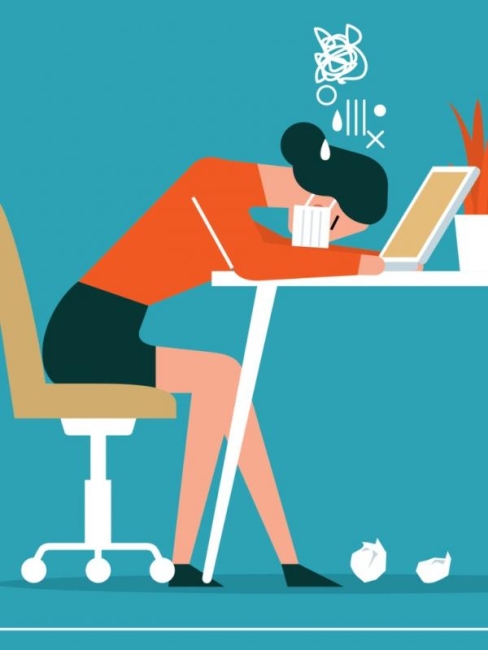You have /5 articles left.
Sign up for a free account or log in.

Istockphoto.com/sorbetto
I wonder how I would have processed the current situation if the COVID-19 pandemic had happened two years ago. For all of my career, I had been hard-charging and productive. I’d received tenure and strong teaching evaluations, published multiple publications including a book with a prestigious academic press, and held leadership roles on campus and in disciplinary organizations -- everything I needed to go up for full professorship in 2018. I looked like I had it all together. My life revolved around my students, writing and the recognition of my work.
But by spring 2018, I woke up every morning with a sense of foreboding and had panic attacks before entering my building and again at my office door. Interacting with students became something to bear and escape. I would rush home and play solitaire on my phone for hours, avoiding everyone save my husband. Though teaching and writing had long been my passion, after 17 years of teaching undergraduates, I was emotionally and physically exhausted, dreaded every single aspect of my work including my students, and felt shamefully empty inside about my work: the three classic hallmarks of burnout as defined by the World Health Organization.
I know how incredibly depressing all of this sounds. But by spring 2019, I had done much of the hard work of rising above the burnout, depression and anxiety. I left my tenured position and moved to Atlanta from North Carolina to work as a faculty developer at a much different institution. Jumping ahead to spring 2020, I’m much happier, healthier and more fulfilled as an academic professional and person for having gone through burnout.
Enter COVID-19.
Having endured burnout, I more easily see it in others, and I see signs of burnout everywhere: #AcademicTwitter threads, disciplinary Listservs, new groups on Facebook and Mighty Networks. Precarity, uncertainty, grief and feeling overwhelmed abound. I see debates about remote versus online learning and whether it is possible to keep courses “normal'” and “rigorous,” more emotional labor than ever before, lamentations about suspended productivity, and a genuine sense of fear and loss for students, colleagues, communities and families. Throw in the new realities of what working from home actually means and increasing fear of not just sickness but losing one’s job, and of course, we are burning out fast. How could we not?
Exhaustion, negativity and cynicism, as well as the loss of feelings of effectiveness and fulfillment, are normal responses to crisis and should not be ignored. All of these emotions are absolutely valid. We simply don’t know what the future holds.
Yet dwelling only on the anxiety and burnout will not help us through these times, even as anxiety producing as they may be. In this spirit, I offer four reflective pillars that were crucial to my own recovery from burnout: focusing on purpose, compassion, connection and balance. Each pillar is a way to reflect on your well-being, consider ways to understand and address your reactions to the added stress, and experiment with curiosity and hope in these unprecedented times.
(Re)articulating your purpose. When experiencing burnout and anxiety, it is easy to forget your purpose for doing the work you do. Many of our actions in this pandemic have been necessarily reactionary -- getting students safely away and closing campuses, moving courses to a remote environment, shutting down research, and canceling rituals such as graduation, for example. In our rush to move to remote instruction, we focused on the technological realities of that transition. Now, however, is the time to focus on articulating and aligning with our core values and purposes again, because we each need them to chart our course though this crisis.
Consider the following questions:
- What are your core professional values, and how can you enact them right now?
- Why do you do what you do, and how can you call upon that purpose now?
- What do you value most about your teaching and/or research? Why do you find that meaningful, and how might you continue to embody those values?
Articulating a sustaining purpose and set of values can help identify ways to overcome the listlessness associated with burnout and potentially find ways to regain some focus and improved ability to complete important tasks and be there for our students.
Practicing compassion. Compassion is a capacity to commiserate with others and feel called to ease their distress. In this context, we must acknowledge how significantly students are impacted by this switch: time zone disparities, disability and accessibility issues, housing and financial precarity, care responsibilities at home, and fear of their futures and those of their families. Cynicism toward students is a hallmark of burnout in faculty members, but practicing compassion reminds us that we can support each other through this uncertain time. Some further questions:
- How are you showing up for your students and mentees online? What do they need to feel safe in class or research discussions? How can you offer them what they need?
- How might you create an environment that validates students’ current intellectual and emotional states but still helps them learn the most important aspects of your course content?
- How can you offer students some grace in this season of uncertainty?
And a bonus question: How are you showing yourself compassion? In a recent webinar I attended, one of the presenters said, “You are not working from home; you are working from the safety of your home in a time of crisis.” This crystallized for me why so many of us are expressing guilt for not being able to write or produce in this moment. We are in survival mode. So how can you practice self-compassion every day? What can you choose not to feel guilty about? How can you offer yourself grace if you simply can’t be productive, remembering that life and health matter more than word count right now?
Seeking out connection. During my burnout crisis, and as an introvert, I didn’t notice just how much I had isolated myself from everyone but my immediate family. Yet opening up to those around me was crucial to my recovery, and it allowed me to hear the stories from peers all around me going through the same thing. And today, I hear so, so many stories.
Shelter-in-place orders protect the population but are necessarily isolating at a time when we need connection more than ever. Many colleagues and I feel as if we are shouting into the digital void, wondering if we are making a difference with our work. But connecting is how we overcome that cynicism and pessimism, so consider:
- How are you connecting with your students right now? How are you modeling humanity for them through your actions and interactions?
- What are you doing to stay connected to your colleagues and teams -- not just to “do” work but to connect, share and support each other?
- What are some new ways to connect with colleagues on and off the campus that might stimulate you intellectually? Who would you invite to join you?
Don’t wait for someone to reach out to you; even just an email, an open hour online to talk with students beyond their coursework, or invitation to a virtual coffee can make a huge difference to someone in all of this unnatural isolation.
Striving for balance. How can we possibly create any sort of balance when we are juggling a whole host of challenges in this crisis? Leaving work at the office, if ever feasible, is undeniably impossible because home is the office. And your office may have a variety of new co-workers, to borrow from the internet meme, who demand time and attention during normal work hours. Balancing work and well-being may seem even more challenging if you no longer have access to other releases such as fitness classes, outdoor activities, meet-up groups and community events.
There are no easy answers here, but consider a few ways you can add some balance in this off-kilter time:
- What fills your cup and gives you energy? What can you do from home to recreate these energizing activities or moments?
- How might you design a morning routine that eases you into work at the start of your day and an afternoon ritual that shuts down your workday?
- What activities can you plan for the times you are “off the clock” (for example, taking a walk, doing a puzzle or paint-by-number, playing a game with your children)?
- What can you not do? What can you put on hold for the time being so that you can focus on priorities and well-being?
Work-life balance isn’t the mythical ideal we lamented in the past. It is a necessary coping strategy right now. Take advantage of your right to put life over work now more than ever.
Did you notice that being productive is nowhere in the four pillars? The guilt we get from not being productive, which itself comes from the prevailing cult of productivity in higher education, doesn’t and shouldn’t have a place among our most important concerns today. These are not conditions for productivity, or even thinking clearly, if we are being honest. But these are conditions that can quickly lead to burnout, especially if you were on that path before the pandemic.
So from my experience with burnout and in the spirit of these four pillars, I urge you to, frankly, underperform. Be mediocre. Do the minimum necessary. We aren’t on sabbatical or vacation. If you are in survival mode, like many of us are, you are likely physically, emotionally and intellectually exhausted -- and that’s OK. Whatever emotions or fears you are feeling right now, they are normal in a crisis, and you are not alone in them. One of the greatest gifts from my burnout experience was allowing myself to feel things but not always do things and to be fine with that.
My best advice? Do the best you can in each moment. Believe that everyone -- from colleagues to students -- is also doing the best they can. My wish for you is to find comfort in understanding your purpose, acting compassionately toward yourself and others, meaningfully connecting with people, and giving yourself permission to practice balance in whatever way sustains you. These four touchstones changed the way I think about and show up in my work for the better. Productivity will be waiting for us when we come out of this, but hopefully burnout will not.




